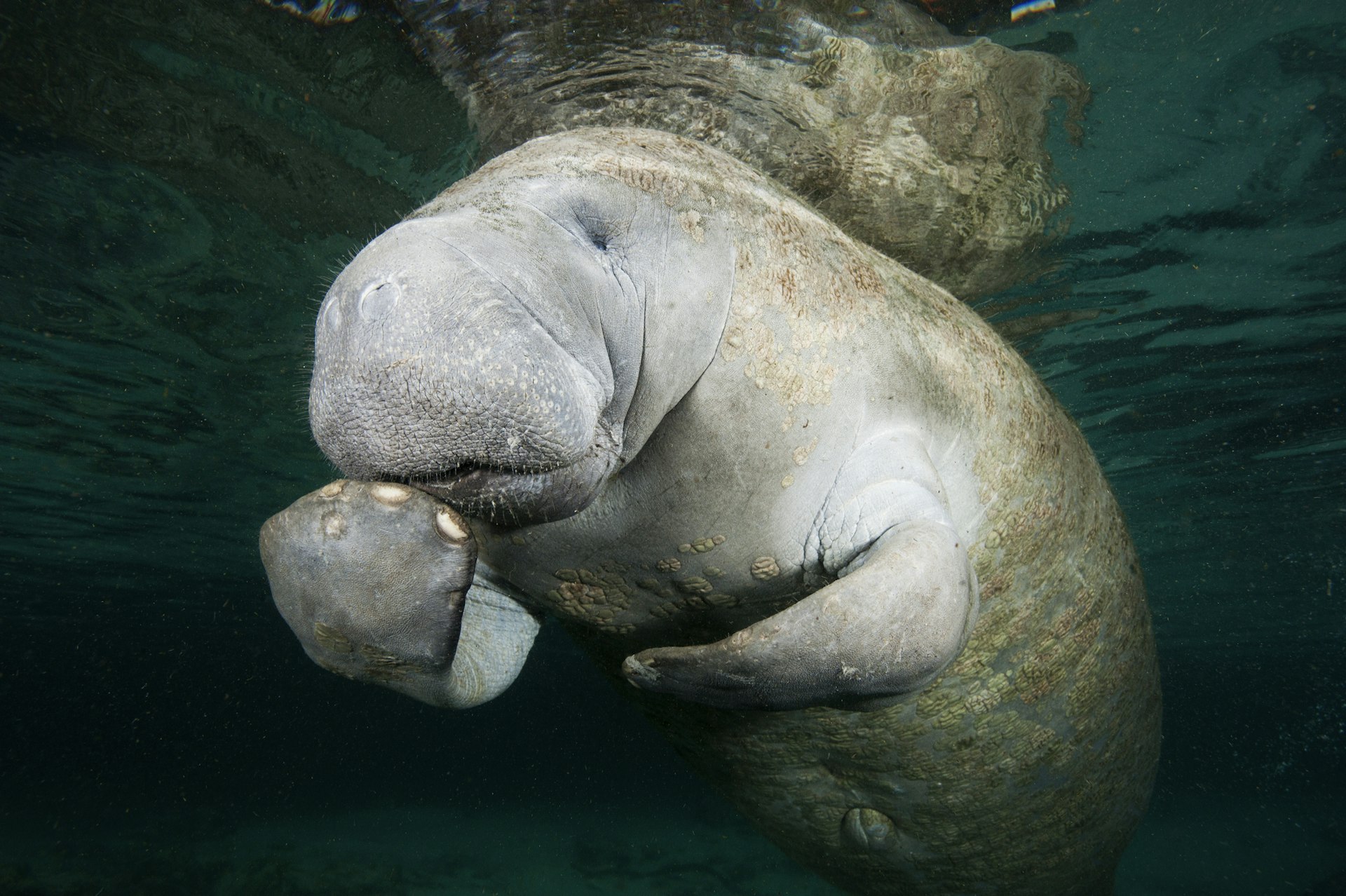
Shell-o! I’m Eva. I have two legs, but I’m really a mermaid. Or at least I’ve always thought I was, ever since I grew up a bespectacled fish-out-of-water in Crystal River, Florida – a small Nature Coast town nicknamed ‘Home of the Manatees’.
When Disney’s The Little Mermaid was released in 1989, I believed Walt Disney had X-rayed my nine-year-old soul. A decade later, as a fledgling writer in New York City, I lived for the annual Coney Island Mermaid Parade – strutting down the boardwalk in my wonky, lovingly-homemade mermaid costumes. I even met my fiancé at a beach lido in southern Italy called La Sirena del Mare (literally ‘mermaid of the sea’).
So imagine my euphoria when I discovered mermaiding, where humans don hyper-realistic mermaid tails and swim in scenic aquatic locales. Even more mer-maizing? My home state of Florida is the epicenter. Here’s how to get into mermaiding.
Immerse yourself in the best experiences the world has to offer with our email newsletter delivered weekly into your inbox.  A pod of mermaids dive into a Florida spring © Dan Compton
A pod of mermaids dive into a Florida spring © Dan Compton
Things to know before you go
Mermaiding can be a hobby, a lifestyle, or even a profession – many merfolk work as performers and mermaid instructors. The rise of mermaiding in the past decade has even led to mermaid tourism, with merfolk traveling to swim in mermaiding hot spots and participate in events.
While mermaiding can represent a magical escape, behind it all is a tight-knit community dedicated to marine conservation and free expression.
“The mermaid community is a place to feel free to be yourself,” says Mermaid Marina Pearl, a 49-year-old Arizona mermaid I meet in a Florida mermaid pod group on Facebook. “Our motto is: ‘You can swim with us.’”
The archetypal image of a mermaid may be a thin, young, white female, but the real-life mermaid community includes all genders, shapes, races, and ages.
“We really value inclusion,” says Mermaid Ché Monique, founder of the body-positive apparel store The Society of Fat Mermaids. “I’ve learned more about folks living with disabilities, gender-equity, and age discrimination issues from this awesome and diverse community.”
One imperative for mermaiding, though, is strong swimming skills. Newcomers should also take a mermaid class to learn how to safely swim in a tail and monofin (a single swim fin inserted into the bottom of your ‘tail’).
My pods recommend Live Free Diving in Palm Beach and Ina’s Mermaid School, which holds sessions in Clearwater and St Petersburg. The latter is just minutes away from my parents’ place. I squeal as I click ‘confirm’.
 Florida’s springs are among the hotspots for mermaiding © Anton Petrus / Getty Images
Florida’s springs are among the hotspots for mermaiding © Anton Petrus / Getty Images
Where to find it
Mermaiding is a worldwide phenomenon. There are pods in the Bahamas, Mexico, Hawaii, Alaska, Morocco, and Albania. “I always tell folks to use Facebook to find their local pod,” says Mermaid Ché Monique. “Having more experienced ‘mers’ to swim with is invaluable.”
In the USA, there are thriving mermaid communities in Texas, California and New England. But thanks to its bountiful springs, year-round swimming, and herds of manatees – once mistaken by sailors for beautiful sea-maidens – Florida has become mermaiding central. And the epicenter? None other than Citrus and Pasco counties – where I grew up.
The area has always had mermaid cred. It’s also home to the iconic Weeki Wachee Springs State Park, which has held underwater mermaid shows since 1947. My friends and I grew up swimming with the manatees in Three Sisters Springs and dreaming of becoming Weeki Wachee mermaids ourselves, but who ever imagined our hometown would become the premier pitstop on a mermaiding pilgrimage?
My ties to the area are how I first learned about mermaiding. Some of my former classmates began to ‘like’ a local Facebook page: Mertailor Mermaid Tails by Eric Ducharme. I clicked and the rest is history.
Ducharme’s stunning tails are wildly popular within the Mermaid community and beyond – his work is featured in music videos and photo shoots – and he now also runs Mertailor’s Mermaid Aquarium Encounter, an exotic-bird and sealife exhibit, which includes an underwater mermaid show.
 “Tee hee hee, I’m a manatee not a mermaid” © Mauricio Handler / Getty Images
“Tee hee hee, I’m a manatee not a mermaid” © Mauricio Handler / Getty Images
Guests marvel as Ducharme’s mermaids – many of whom, like Ducharme, got their start at Weeki Wachee – swim among fish while wearing silicone Mertailor tails so realistic you’d expect them to feel fishy when touched.
Ducharme, 33, tells me that he’s been making tails since he was little using “duct tape and whatever I could find.” These days he uses spandex, water-repellent wetsuit material, or silicone, which he paints by hand.
So where will you take your tail? Florida has gorgeous coasts, but its most popular mermaiding spots are its mild, clear springs, like Alexander Springs, Ginnie Springs and Rainbow Springs. Mermaid DD, a 51-year-old mermaid in Miami who performs as the String Siren, points out that while sea swimming is wonderful, “the sand and waves can make it more challenging, and [renting] boats cost money.” Note: not all springs allow tails.
Wherever you go, think twice before you tag your location on social media, says Cecíl Mullan, a 27-year-old PADI divemaster and mermaid instructor in Orlando.
“We try to protect these precious sites from being overrun by tourists,” says Mullan, “by tagging social media post locations simply as ‘Tag Responsibly – Keep the Spring State Wild’ instead of the specific spring we’re at.”
I’m not ready for the springs just yet, so I drive to mermaid class, knees shaking. I meet Mermaid Ina and Mermaid Bettina – the latter is a new classmate, who’s just as nervous as I am. But when Mermaid Ina brings out her trunk o’ tails, Mermaid Bettina and I both scream like four-year-olds. My tail is purple; Mermaid Bettina’s is fuchsia.
We are taught how to slide our monofin into the tail “skin” and do the mermaid swim stroke – a dolphin-like shimmy. Once we’ve gotten the hang of it, she scatters gems into the pool for us to retrieve, then shows us how to blow underwater “mermaid kisses” and turn somersaults.
There’s a mirror fixed to the side of the pool so we can see ourselves sluicing through the waves as Mermaid Ina films us. When she later texts me the video, I can barely believe my eyes. It’s me – a real mermaid. Finally.
 Mermaiding is an inclusive hobby © Merman Andrew
Mermaiding is an inclusive hobby © Merman Andrew
The details
As liberating as mermaiding can be, personal safety and respect for the environment is paramount. Merfolk take great care to swim when bodies of water will be less crowded, like early mornings and weekdays, and particularly on Mermaid Monday, the unofficial mer swim day.
“Do plenty of research or call dive shops in the area to ask about conditions – current, water clarity, depth, bottom composition,” warns Mullan. “Definitely call ahead to ask if the place you want to go allows mermaid tails… be polite and courteous and follow all posted signage and rules.”
Namely: pick up trash, keep a respectful distance from wildlife, and be considerate of the area’s regulars.
Also never swim alone, says Merman Andrew, a 29-year-old professional merman from Tampa. “Things can happen. You can get stuck on a rock or something like that,” he says me. “Mermaiding can be dangerous if you’re not properly trained.”
Keep it going
Adopt some mer lingo like ‘shell-o’ (hello), ‘mermaiz-ing’ (amazing), and mer-sona (your mermaid alter ego). At the beginning of class, Mermaid Ina asks what our mersona is – of course, I’m Mermaid Eva.
Other terms to learn: ‘mer-momma’ (anelder mer who guides other mers), ‘mer-sis’ and ‘mer-bro’ (“We treat each other like family,” explains Ariel Stein, a 35-year-old Orlando, FL mermaid), and ‘Mer-tender’ (a mermaid’s non-mer partner who helps them get dressed and, if needed, carries them to the body of water). In other words, my fiancé,
You can dive even deeper into mermaiding with Weeki Wachee’s Sirens of the Deep Mermaid Camp, where you’ll learn mermaid performance basics. There are also a growing number of annual Mermaid events and conventions throughout the United States, like MerMagic Con in the greater Washington D.C. area; the Afro Mermaid Summit in Miami, FL; the California Mermaid Convention; the Key West Mermaid Festival; the San Marcos Mermaid Festival; and Spring Splash in Florida’s Ginnie Springs.
You can even attend a mermaid retreat, like Mermaid Ina’s three-day Mermaid Intensive featuring mermaid yoga and mer-makeup and -hair lessons, or Mermaid Ché Monique’s 8-day Red Sea Adventure, where you’ll swim with dolphins and glam it up on a private yacht.
 Mermaid Eva tries mermaiding for the first time © Eva Sandoval / Lonely Planet
Mermaid Eva tries mermaiding for the first time © Eva Sandoval / Lonely Planet
Take it home
The ultimate take-home mermaiding accessory is the tail; there are many mermaid tail crafters who offer exquisite silicone and fabric options. Fabric tail “skins” require a separate monofin; silicone tails have monofins built in.
Mermaid community favorites include the Mertailor, Jurassic Merman and MerNation in Florida, Merbella Studios, the budget-friendly Fin Fun in Idaho, Mermaid Kariel in Hawai’i, MerrowFins, Mermaid Kat’s customizable silicone tails in Germany, and Kiki Von Mermaid, who sells custom accessories. Many merfolk have multiple tails.
“[I have] about twelve tails in total, with another on order,” says Krista Fleig, a 35-year-old mermaid, freediver and mermaid instructor in Port Lucie. “Every tail maker is an individual artist creating magnificent works that we get to swim and perform in. Every mer will have their favorite for colors, fluke shapes, ease of wear, and price.”
Be prepared to invest: tails can range from $100 to thousands of dollars. Mermaid Ina’s course gave me the option to rent or buy a spandex tail; I opted to rent and have regretted it ever since. Other classes might offer take home options like photos or videos or a mermaiding success certificate.
How to prepare
Mermaid kit essentials inlcude: tail, light snacks and water, a dry change of clothes, and a towel. You might also want to pack sinus savers, eye drops, mask, snorkel, weight belt, lifeguard rescue tubes, and a GoPro-style camera to capture the magic.
Be mindful when it comes to accessories, says Mermaid Marina Pearl: “As mermaids, we have a responsibility to make sure that our costumes are as marine-safe as possible; no glitter in open bodies of water, no accessories that can fall off and clog waterways or get swallowed by fish, turtles, etc, and of course, reef safe sunscreen to protect our fragile corals.”
Once you’ve mastered swimming with a monofin and have your safety person, you’re ready to hit the water. Prep the night before so you can get on the road as early as possible, then fuel up with a light breakfast, and do some pre-swim stretching.
Sea you there, angelfishes.



